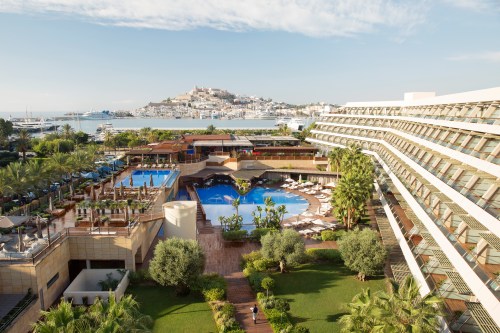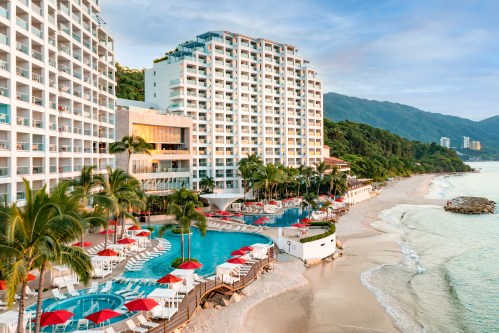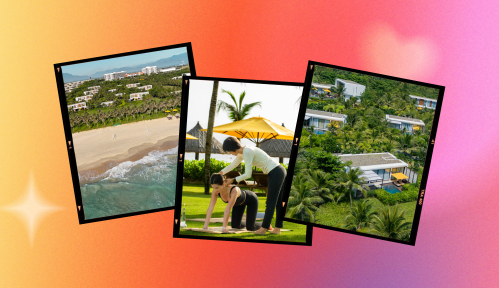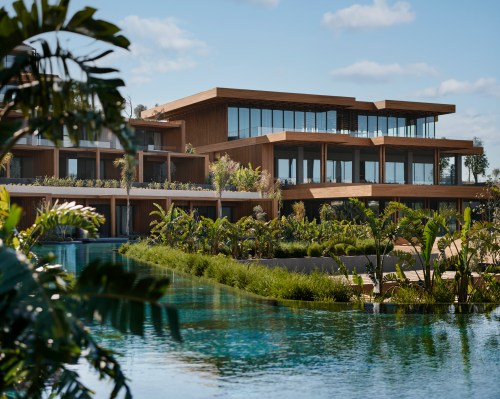With ‘Revenge Travel’ in Full Swing, How Can We Prevent a Return to Overtourism?
Travel experts share advice on how we can all travel more responsibly and prevent the return of overtourism in a post-pandemic landscape.

More people traveled internationally in 2019 than in any previous year—a whopping 1.5 billion of them—rounding out a 10th consecutive year of tourism growth. But along with money to spend, boosting a number of tourism-dependent economies, this record mass of travelers would also bring new levels of crowding, noise, and pollution. Cue: the phenomenon of overtourism, describing how places too well-traveled become socially and environmentally depleted.
Experts in This Article
co-founder of Elsewhere
co-founder and CEO of Regenerative Travel
Cat Jones is the founder and CEO of B Corp travel operator Byway, which offers flight-free travel planning.
Harold Goodwin, PhD, has worked on four continents with local communities, their governments, and the inbound and outbound tourism industry. He is an Emeritus Professor and Responsible Tourism Director at the Institute of Place Management at Manchester Metropolitan University, Managing Director of the Responsible Tourism Partnership and advisor to the World Travel Market on its Responsible Tourism programme at WTM London, which attracts 2000 participants each year, and WTM Africa and Latin America and Arabian Tavel Market. He chairs the panels of judges for the World Responsible Tourism Awards and the other Awards in the family, Africa, India and Latin America.
Justin Francis is the co-founder and CEO of activist travel company Responsible Travel. After completing a master’s degree in responsible tourism, Justin Francis founded Responsible Travel in 2001 with Harold Goodwin, his course tutor. The online travel agency was one of the first to offer carbon offsetting in 2002, only to drop it 10 years ago, seeing it as a distraction to the work necessary to reduce global carbon emissions from the outset.
president and managing director of the Americas at Intrepid Travel
Rocio Vázquez Landeta is the founder of Eat Like a Local Mexico City, a boutique travel company focused on creating culinary expeditions in Mexico City.
Thanks to the rise in cheaper flights, the explosion of short-term rental offerings, and the advent of social media popularizing a select few destinations, places like Barcelona, Amsterdam, and Venice fell prey to such a big overtourism crisis, in fact, that some residents staged anti-tourism campaigns. Then, the pandemic hit in 2020, and it all reversed course: The tourism industry collapsed, dropping by 1 billion travelers. Now, as travel returns in earnest, both its upsides and downsides are more salient than ever, giving jet-setters the opportunity to recreate a tourism landscape with more balance.
The pandemic made the effects of overtourism impossible to ignore
In many places, the unique opportunity to glimpse a world without tourism in 2020 shed new light on how big of a crisis overtourism had become. “The tourism break forced by the pandemic produced widely publicized effects, such as the return of fish to the Venice canals,” says Cat Jones, founder and CEO of B Corp-certified travel operator Byway, which offers flight-free travel planning. In other parts of the world, leatherback turtles lounged in place of tourist crowds on Phuket Beach in Thailand, and humpback whales started to communicate with each other more effectively absent the din of cruise ships in Alaska. Not to mention, many humans living in Europe’s tourist hubs found the relative calm to be a breath of fresh air—perhaps literally, too, as global carbon emissions dropped by 7 percent year-over-year from 2019 to 2020.
But at the same time, in countries where tourism comprises a significant piece of the economy, the pause sparked economic downturn; just take Grenada and Macao, whose GDPs contracted by 13 and 56 percent, respectively, due to a loss in tourism revenue. And in other regions, the loss of tourism money actually had environmental drawbacks. “In southern Africa, tourism dollars are extremely crucial for conservation—for preventing poaching for bushmeat—and for developing local communities,” says Alexis Bowen, CEO of Elsewhere, a travel-planning company that links travelers with local experts. Without visitors and their money, in 2020, these regions saw a surge in poaching of animals like rhinos and elephants.
The question, then, for travelers and stakeholders in the tourism industry is how to achieve the Goldilocks of travel: enough to sate our natural wanderlust and support global economies, but not so much that it leaves places culturally and environmentally degraded. And the time to figure out an answer is right now, as people are plotting their “revenge travel” plans, or seeking to travel more (and more extravagantly) than ever in order to make up for lost pandemic time.
“Once travel stopped, we were all given the chance to think about restarting it differently.” —Matt Berna, President of North America at Intrepid Travel
“We’re seeing a lot of pent-up demand from both new customers and people who still have trip credits from 2020 and are eager to get back at it,” says Matt Berna, President of North America at Intrepid Travel, a B Corp-certified small group travel company. In fact, the first three months of this year saw an increase in international travel of 182 percent compared to 2021, and surveys gathering public interest in travel are predicting that the industry will make a full recovery this year, too.
But also, during this travel lockdown, tourist boards in popular destinations have had much-needed time to assess the impact of overtourism and develop strategies for mitigating it, says Jones. For example, she adds, Marseille introduced a summer permit system to manage visitors to the Sugiton calanque, and Amsterdam introduced restrictions on short-term visits, as have other cities like Barcelona, which is also planning a new tax for cruise-ship visitors. The goal of these adjustments—which also include additional tourism taxes, particularly for day visitors in places like Venice and Bhutan—is to help improve destination infrastructure so that it’s easier to manage large swaths of tourists at once, says Justin Francis, co-founder and CEO of Responsible Travel, an activist travel company.
These kinds of shifts, coupled with people’s renewed interest in travel, makes the current moment an important juncture for the industry—one that could set the scene for what comes next, says Berna. “Pre-pandemic, the tourism industry was just full-motion, full-steam ahead, which makes it really hard to create change,” he says. “Once travel stopped, though, we were all given the chance to think about restarting it differently.”
5 key tips to prevent a post-pandemic return to overtourism
1. Pivoting from overtourism to undertourism
The burden created by overtourism stems from too much of a good thing: Too many visitors beyond what a place can reasonably manage leads not only to environmental issues (destruction of natural or historical places and wildlife, along with excess air, water, and land pollution), but also to economic issues (degradation of other sectors of the economy and a reliance on seasonal revenue) and social issues (tourists creating inconveniences for locals, like crowding and noise).
Once crowding near popular destinations reaches a certain magnitude, locals will simply stop going to these tourist hubs, says Harold Goodwin, PhD, managing director of the Responsible Tourism Partnership. “Suddenly, tourists notice that they’re not meeting anybody from Barcelona in, say, Las Ramblas, and that’s when they can see it as an overtourism problem.”
“Undertourism is about getting off the beaten track, being more meaningful about how you travel, and going to places where the residents are actually welcoming you.” —Matt Berna, President of North America at Intrepid Travel
In cases like this, when locals are essentially driven out of their neighborhoods, part of the solution may be redirecting travelers to less-visited regions—something that Berna calls undertourism. “The concept of undertourism is about getting off the beaten track, being more meaningful about how you travel, and going to places where the residents are actually welcoming you,” he says. That could also look like traveling to popular places in shoulder seasons, he adds, when they’re less likely to be packed. The point is to more evenly distribute both travelers and the economic benefits they bring with them across various locations and throughout the year.
On Intrepid Travel, you’ll find trips to lesser-traveled countries like Bosnia and Herzegovina and Latvia and to under-appreciated regions near hotspots, like southern Crete in Greece and Lastovo in Croatia. And when you connect with a local expert via Elsewhere, you’ll be given similar kinds of alternatives based on the popular places you might’ve otherwise chosen.
“To the person who’s eager to visit Tuscany, for example, our expert might say, ‘Yes, Tuscany is amazing, but Umbria is just as amazing and even better to visit because there are way fewer tourists,’” says Bowen. That makes for a more responsible and sustainable choice, but also likely a more memorable one, too. “You could find that you have an even more authentic experience in Umbria with more opportunities to make connections with locals,” she says.
2. Slowing down travel
Spending more time in a single destination—versus, say, bopping around a few places in a week—is, in itself, one way to combat overtourism. Not only are you sparing the environment some carbon emissions by traveling less in total, but also, you’re giving yourself more time to get immersed in a single destination and contribute to the local economy, too (more on that below).
In the same realm, you might also consider taking a slower route to your destination by opting for a train, bus, or ferry, if possible, as opposed to flying, which has a greater environmental impact, says Jones. “Also, planes often drop you right into tourism hubs, but just consider all the lovely destinations that trains often stop at,” she adds.
Once you’re situated in a place, it’ll also behoove both you and the destination to get around by foot or by bike, says Berna, who notes that biking-focused itineraries are one of Intrepid’s fastest-growing trip styles. Both walking and biking reduce your contribution to carbon emissions and also give you more opportunities to interact with locals and uncover local shops and restaurants—all of which increase the chance that you spend your money in meaningful ways, he says.
3. Staying “like a local”
To make your trip net-positive for the place where you’re staying, it’s essential to give more than you take—or, in other words, leave the place better than you found it. That’s the idea behind regenerative travel, which can certainly look like volunteering or staying at an agritourism farm, but can also simply mean engaging with local culture and supporting the local economy or environment whenever possible.
One of the destinations best known for prioritizing this kind of travel and protecting its residents in the process is Hawaii, says Amanda Ho, co-founder of Regenerative Travel, a travel company that connects travelers with independent hotels dedicated to supporting the environment and economy in which they’re located. “Since the pandemic, Hawaii launched ‘Malama,’ which is a program incentivizing travelers to give back to the local environment through activities like beach cleanups and tree plantings offered by partner hotels, and in exchange, they get a discount or free night’s stay.”
“So little of the tourism industry’s profits actually stay in the local economy where they’re generated.” —Alexis Bowen, CEO of travel-planning company Elsewhere
Beyond specific programming, though, it’s possible to practice regenerative travel by simply embracing local everything—eating at local restaurants, using local tour guides, staying at locally owned hotels or hostels—so that your money flows back to the people supporting your stay. “So little of the tourism industry’s profits actually stay in the local economy where they’re generated, and this economic leakage is the biggest issue we’re trying to solve,” says Bowen.
When you engage with local service providers, you’re also increasing the chances that the activities you’re doing are both socially and environmentally responsible, says Bowen, largely because residents tend to consider the needs of the places in which they live more directly than foreign service operators do. “Local experts are the ones who are thinking about their communities and paying fair wages to their fellow residents and aiming to offset mass footfall to over-traveled places,” she says.
Locals are also the people who can offer a unique experience, says Bowen—one filled with hidden gems and off-the-map locales that you’re sure to remember once the trip is over. And that’s exactly what people are craving right now, too. In fact, a recent survey of 3,000 people conducted by American Express found that 81 percent of people want to travel to destinations where they can immerse themselves into the local culture.
“We’re finding that people are less concerned with the consumption of travel and getting that stamp on their passport or checking off that hotel that has five stars, and they’re more interested in having an immersive experience,” says Bowen, who launched Elsewhere last year to provide just these kinds of experiences.
Also in the past year, the luxury travel-planning app Origin launched with a model that connects members with local travel planners to curate personal trips; and travel website Culture Trip launched TRIPS by Culture Trip to offer small-group adventures led by local experts. “The new luxury isn’t 800-thread-count sheets,” says Bowen. “It’s watching the sunrise over the Himalayas with a dollar’s worth of dal bhat.”
4. Vacationing with purpose
Part of the reason why certain popular spots fell victim to overtourism pre-pandemic is the way that social media has hyped them up. Instagram, in particular, has made it easier than ever to see where your friends and trusted influencers are traveling and to then simply follow in their footsteps.
The resulting trend: Plenty of people are just traveling somewhere for the “trophy selfie,” says Dr. Goodwin. You can imagine how this has created undue crowds at vulnerable destinations from the Taj Mahal to the Grand Canyon. “Geotagging places when taking pictures for Instagram can drive thousands of other people to take the same shot, which contributes to tourism problems and makes locals very uncomfortable,” says Rocio Vázquez Landeta, founder of Eat Like a Local Mexico City, which offers women-led food and sightseeing tours in Mexico City.
An antidote? Simply taking a minute to consider the purpose you’d like for your vacation to serve, well beyond any photograph. “You know yourself better than anyone else does,” says Dr. Goodwin. “When you think about travel, consider the kinds of experiences that would be the best recreational experiences for you—in the traditional meaning of that word, as in, the ‘re-creation of self.’”
One way to figure out what you’d really like your next vacation to look like is to reflect on previous vacation experiences that made an impact on you, Dr. Goodwin adds. “Think about the most memorable part of your last holiday,” he says, “and how you might re-create that experience.”
5. Embracing the ‘guest’ attitude
Part of being a responsible tourist is remembering that you’re just that: a tourist. “Adopting this attitude—that you’re a guest when you travel, that you want to be welcomed wherever you go and make a positive impression on the place and people—can make a big difference,” says Berna. In that mindset, you’re more likely to respect the local community and culture, “which could mean doing something as simple as learning a few greetings in the local language,” says Ho.
In the wake of a global crisis, that level of understanding and kindness feels all the more accessible. “The pandemic showed us how interconnected we all are, and how much we value the same things, which are human connection and safety,” says Bowen. “What we try to do is ensure that our travelers feel that sense of connection and learn about local culture, so they can visit sites respectfully.”
After all, it’s incumbent on the traveler to do at least that much in exchange for a wholly unique travel experience—one that goes beyond what money can buy. “It’s important to understand that travel is not a human right,” says Landeta. “It is actually a privilege.”









